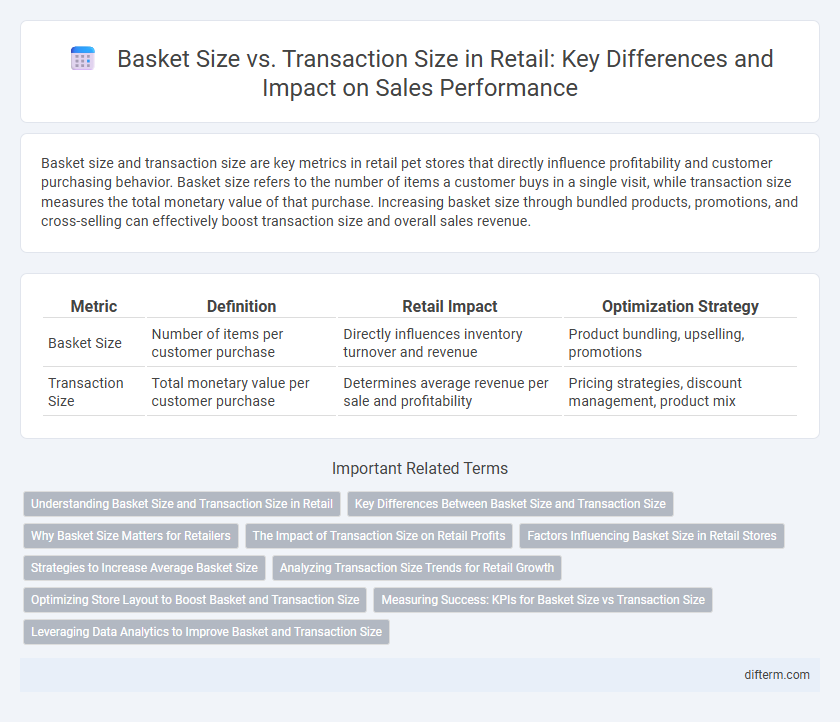Basket size and transaction size are key metrics in retail pet stores that directly influence profitability and customer purchasing behavior. Basket size refers to the number of items a customer buys in a single visit, while transaction size measures the total monetary value of that purchase. Increasing basket size through bundled products, promotions, and cross-selling can effectively boost transaction size and overall sales revenue.
Table of Comparison
| Metric | Definition | Retail Impact | Optimization Strategy |
|---|---|---|---|
| Basket Size | Number of items per customer purchase | Directly influences inventory turnover and revenue | Product bundling, upselling, promotions |
| Transaction Size | Total monetary value per customer purchase | Determines average revenue per sale and profitability | Pricing strategies, discount management, product mix |
Understanding Basket Size and Transaction Size in Retail
Basket size in retail refers to the total quantity of items a customer purchases in a single shopping trip, while transaction size denotes the overall monetary value spent during that purchase. Analyzing basket size helps retailers optimize product placement and inventory, whereas monitoring transaction size informs pricing strategies and promotional effectiveness. Combining insights from both metrics drives revenue growth and enhances customer purchasing behavior understanding.
Key Differences Between Basket Size and Transaction Size
Basket size refers to the number of individual items a customer purchases in one shopping session, while transaction size measures the total monetary value spent in that transaction. Basket size emphasizes quantity and variety of products, whereas transaction size focuses on the revenue generated per purchase. Understanding these differences helps retailers optimize product assortment and pricing strategies to boost overall sales performance.
Why Basket Size Matters for Retailers
Basket size, representing the number of items per purchase, is crucial for retailers as it directly influences revenue and inventory turnover. Larger basket sizes indicate higher customer engagement and increased average transaction values, driving profitability and optimizing stock management. Retailers focusing on boosting basket size can improve customer lifetime value while reducing per-transaction operational costs.
The Impact of Transaction Size on Retail Profits
Transaction size directly influences retail profits by determining the total revenue generated per customer interaction, with larger transactions typically increasing profit margins due to fixed operational costs being spread over more products. Higher transaction sizes often correlate with improved inventory turnover rates and enhanced customer lifetime value, driving sustained business growth. Retailers optimize transaction size through strategic upselling, product bundling, and personalized promotions to boost overall profitability.
Factors Influencing Basket Size in Retail Stores
Basket size in retail stores is influenced by factors such as product variety, pricing strategies, and promotional offers that encourage customers to add more items per visit. Store layout and product placement also play critical roles, as easy access to complementary goods and impulse purchases can increase the average number of items per basket. Customer demographics, including income level and shopping frequency, further impact basket size by determining purchasing power and shopping habits.
Strategies to Increase Average Basket Size
Increasing average basket size in retail can be achieved through targeted cross-selling and upselling strategies, such as personalized product recommendations and bundle offers designed to complement each customer's purchase history. Implementing dynamic pricing and loyalty programs incentivizes higher spend by rewarding customers for exceeding specific transaction thresholds. Utilizing data analytics to identify trending products and shopper preferences enables retailers to optimize in-store layouts and marketing campaigns that encourage adding more items per transaction.
Analyzing Transaction Size Trends for Retail Growth
Analyzing transaction size trends reveals critical insights into customer purchasing behavior, enabling retailers to optimize basket size strategies for increased revenue. Data shows that larger transaction sizes often correlate with higher basket sizes, driven by effective upselling, cross-selling, and personalized promotions. Retailers leveraging advanced analytics to understand and influence these patterns can enhance average order value and drive sustainable retail growth.
Optimizing Store Layout to Boost Basket and Transaction Size
Optimizing store layout significantly impacts both basket size and transaction size by strategically placing high-margin and frequently purchased items in high-traffic areas, encouraging shoppers to add more products to their baskets. Effective use of space, such as end caps and impulse buy sections near checkout lanes, enhances product visibility and prompts additional purchases, thereby increasing average transaction value. Retailers leveraging data-driven insights to tailor product placement based on consumer behavior experience measurable growth in both basket size and overall sales performance.
Measuring Success: KPIs for Basket Size vs Transaction Size
Basket size and transaction size are critical KPIs for measuring retail success, reflecting average items per purchase and total revenue per transaction, respectively. Optimizing basket size indicates effective cross-selling and product bundling strategies, while tracking transaction size highlights overall customer spending power and pricing efficiency. Monitoring these metrics helps retailers tailor marketing efforts, improve inventory management, and increase profitability by balancing product variety with transaction value.
Leveraging Data Analytics to Improve Basket and Transaction Size
Leveraging data analytics enables retailers to analyze purchasing patterns and customer behavior, driving strategies to increase both basket size and transaction size. By identifying high-margin products frequently bought together, personalized promotions and product bundling can be optimized to maximize average spend per visit. Advanced analytics also predict optimal pricing and inventory levels, ensuring a seamless shopping experience that encourages larger, more frequent transactions.
Basket Size vs Transaction Size Infographic

 difterm.com
difterm.com